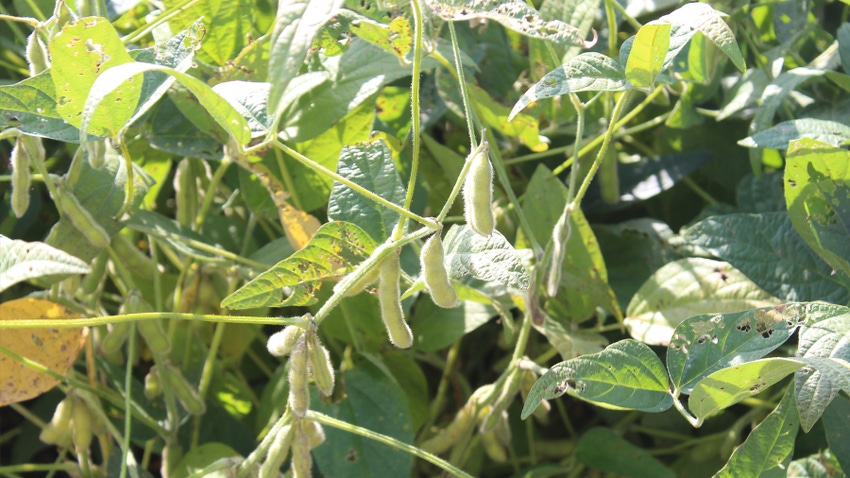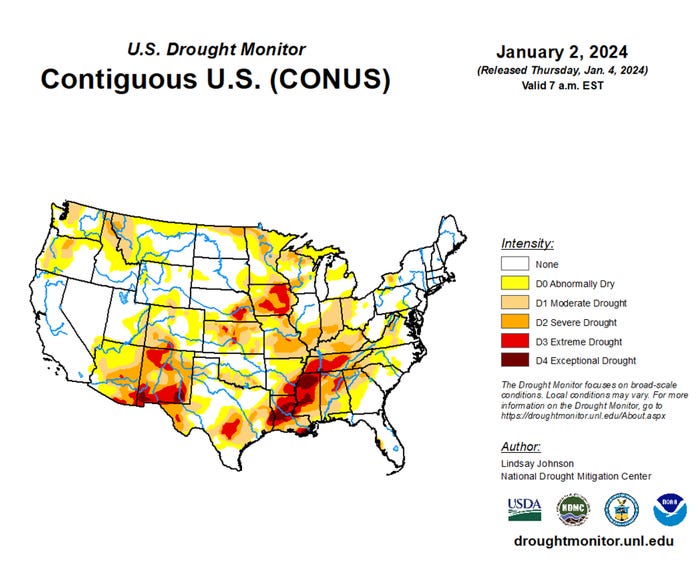
Despite recent precipitation, much of the Great Plains and Midwest are still experiencing some form of drought.
According to U.S. Drought Monitor map for Jan. 2, much of Kansas, Missouri, Iowa and parts of Nebraska saw abnormal to extreme drought conditions. The U.S. Monthly Drought Outlook from the Climate Prediction Center calls for drought conditions to persist through much of the same area through January.
Livestock producers have had to look to unconventional feedstuffs in recent years, and one alternative that has become more attractive to some is soybean hay. Justin Waggoner, K-State Research and Extension beef specialist, says soybean hay has been an alternative for farmers looking to salvage their soybean crops that were hit with drought.
According to the K-State Research and Extension News Service, Waggoner says the key is to know what products were applied to the soybeans in the field, and how the crop was harvested, baled and stored.
Feeding cattle
According to experts at University of Minnesota Extension, soybeans were initially a forage crop in the 1800s when they were introduced to the U.S.
And grain-type soybeans can be harvested for hay or silage, with a forage quality similar to flowering alfalfa.
Depending on their maturity, soybeans may be higher in protein than corn, or small-grain silages, and tend to be highly digestible, according to University of Minnesota Extension.
Cattlemen or dairymen considering feeding soybean hay or silage need to consider how increased grain fill, leaf-to-stem ratio and pod fractions can influence the forage quality as well. This can affect how a beef or dairy farmer builds their feeding program around soybean forage or silage.

DROUGHT MONITOR: The U.S. Drought Monitor map for Jan. 2 shows abnormal to extreme drought conditions in much of the middle part of the country. The U.S. Monthly Drought Outlook from the Climate Prediction Center calls for drought conditions to persist through much of the same area through January.
For beef and dairy cattle, University of Minnesota Extension warns that soybean hay should be ground and mixed with other roughages such as corn silage, corn stover or grass hay to not only reduce waste, but also eliminate the risk of bloat.
Extension experts also strongly recommend that before feeding, cattlemen test their soybean forage feed value so they know exactly how they can best feed it, depending on the class of cattle.
For beef cattle, introduce soybean silage at an inclusion rate of less than 50% of the diet on a dry basis. After several weeks of this introductory rate, then you can increase the rate of soybean silage by 10%. Pay special attention to how much of the soybean forage is made up of soybean seed. If it’s more than half of the soybean forage, that high concentration of dietary fat from the soybean seed could cause scours, digestive upsets, and in severe cases, even ammonia toxicity.
For dairy cattle, University of Minnesota Extension recommends soybean forage make up only 15% to 20% of a dairy ration without a significant effect on intake or milk production. Still, dairy farmers should expect lower dry matter intakes of soybean forage compared to an alfalfa or corn silage ration.
Harvest considerations
Steve Niemeyer, Nebraska Extension educator, says before farmers consider pulling the pin on harvesting their soybean grain crop for forage, they should first consider the weather forecast. An August rain could save a crop, he warns.
However, it’s good to have a plan in place because farmers need to get into the soybean field to cut it for forage before leaves turn yellow and start to drop, leaving much of its nutrient value in the field.
Niemeyer warns that soybean hay is not as forgiving as alfalfa or prairie hay to put up. Leaves dry quickly and will crumble if raked, and the woody stems dry slowly, he says.
Use a conditioner or crimp the hay to hasten the stem drydown and avoid raking. He also advises that if you must rake to merge windrows for baling, do it within one day of cutting to prevent leaf loss.
Mike Staton with Michigan State University Extension also offers these tips for success:
Check with your crop insurance agent before you harvest. And make sure you’ve also communicated with your USDA Farm Service Agency office to see if harvesting the field for forage will affect your USDA program eligibility.
Check the labels of any herbicides, pesticides or fungicides you may have applied to the field to ensure that you can feed the treated crop. Some may allow treated soybeans to be harvest for hay, but not for silage. Others may not allow harvest for hay or silage at all.
If cutting soybeans for hay, aim for soybeans in the R3 to R5 growth stages for more leaves and fewer shattered pods. And consider humidity levels when you’re handling the crop to avoid leaf loss.
If cutting for silage, those harvested at R3 to R5 will have higher quality forage and lower oil content than those harvested at R6. However, soybeans at R6 will produce more dry matter. And be sure to collect samples from the chopper to determine the whole plant moisture content to achieve proper fermentation.
To learn more, visit these websites:
UNL: beef.unl.edu
Minnesota: blog-crop-news.extension.umn.edu
Michigan: canr.msu.edu/news
About the Author(s)
You May Also Like






